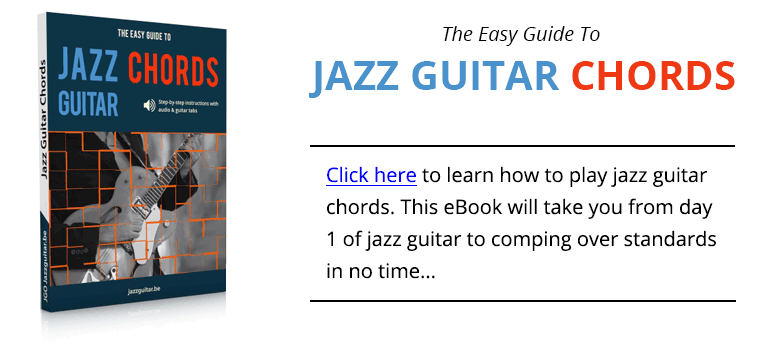One of the most famous chord progressions in jazz, and one of the ones you encounter early in when learning how to play jazz guitar, is the descending minor chord progression that starts the tune “My Funny Valentine.”
While many of us have played these changes, and can probably recognize them by ear, as guitarists we often fall back on one or two ways of comping through these chords when we play this tune.
In this jazz guitar chord lesson, we’ll be looking at 10 different ways that you can comp through the opening bars to My Funny Valentine using different chord shapes, string sets, and voice movement.
My Funny Valentine Chord Progression
To begin, let’s take a brief look at the theory behind this chord progression.
The chords that make up the opening bars to My Funny Valentine are:
| Cm | CmMaj7 | Cm7 | Cm6 |
| Im | ImMaj7 | Im7 | Im6 |
What makes these chords work so well, and causes them to be so aurally distinct, is the descending movement from the root through the major 7, minor 7 and finally resting on the 6th of the underlying chord.
In the examples below, you will learn how to put that descending chromatic line (C-B-Bb-A) in the bass, middle voices and melody line of the chord progression.
This will give you the option of focusing on that descending in the top of your chords, middle of each voicing or as a descending bassline when using these shapes in your jazz guitar chord playing.
My Funny Valentine Chords Practice Tips
To help you dig into these progressions, beyond just learning the shapes on the guitar, here are 5 ways that you can practice these chords in order to get them fully under your fingers, into your ears and into your jazz guitar chord playing.
- Play a chord progression in all 12 keys around the neck.
- Comp through My Funny Valentine and use a different progression each time you hit the Im-ImMaj7-Im7-Im6 section of the tune.
- Play one or more of the progressions and sing the moving line R-7-b7-6 as you comp the chords on the guitar.
- Practice these progressions with different grooves such as swing, ballad, Samba, Salsa, Bossa Nova etc.
- Write out 5 variations of these chords that you’ve come up with on your own, with either new voicings or using combinations from the 10 listed below.
10 Ways to Comp My Funny Valentine Chords
Here are the 10 variations on the opening bars to My Funny Valentine, with audio for each example above the tab/notation.
Grab your guitar, turn up your amp and have fun!
My Funny Valentine Chords 1
My Funny Valentine Chords 2
My Funny Valentine Chords 3
My Funny Valentine Chords 4
My Funny Valentine Chords 5
My Funny Valentine Chords 6
My Funny Valentine Chords 7
My Funny Valentine Chords 8
My Funny Valentine Chords 9
My Funny Valentine Chords 10
Have a question or comment about this lesson? Post it in the comments section below.













Hey! NO “Stairway to Heaven” !
This is only the intro, isn’t it?
having trouble with the last two, any advise?
Very useful…. I notice the way very simple is often the most effective.
Impresionante ! it’s an excellent song . like the lyrics of Chet Beker.!
Nice decending minor chord patterns…great for practice in different progressions!
Please allow me to slightly disagree. I know that “My Funny Valentine” is notated that way in the Real Book. However this is misleading IMHO.
The first 8 bars should be read as this:
| C | C/B | C/Bb | C/A |
| Abj | F-7 | Dm7b5 | G7b9 |
The point is the chromatically descending bass line. I’d even suggest to play a Pedal Ab in the bass in bar 5, 6 and 7 and descending to G in bar 8.
That in mind I personally would only choose your suggestions 5-8, but only if there is no bass player present. If there is a bass playing that chromatic line, why not try playing a Cm triad (without 7 or 6) and adding a top line of notes like:
(This are top notes, not chords)
| Eb | D | Db | Db |
| Ab | C | C | B |
The resulting chord are:
| Cm | Cm j7 ad9| Eb7 13/Bb | A7+11 |
| Fm7/Ab| Abj | Bb79/Ab | Db7/Ab |
If I knew how to insert a JPG in this comment, I’d suggest a voicing.
Just my 2C
It’s also the source of Lennon/McCartney’s Michelle intro…which possibly has a more satisfying resolution…
love the consept its a cool to learn your guitar
I use #7 as the intro because I find it easy to fit the melody around it. It’s great to see more ways to work with this wonderful tune!
This is a great lesson. This is what really helps me. Learning chords all around the neck using progressions. THNAKS!